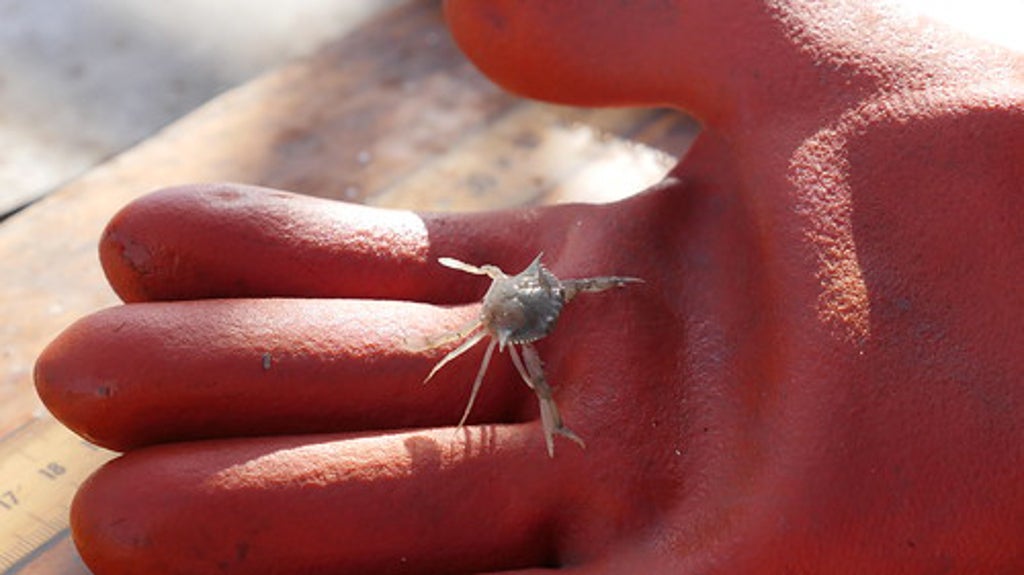
The number of blue crabs in the Chesapeake Bay hit a record low, marking the lowest count in more than three decades of tracking the crustaceans, experts said.
The annual Baywide Blue Crab Winter Dredge Survey, which comes up with an estimate of the blue crab population, this year tallied 227 million crabs, the “lowest abundance observed since the survey began in 1990,” said the authors of the count.
Officials say the survey by the Maryland Department of Natural Resources (DNR) and the Virginia Institute of Marine Science (VIMS) is key to knowing how to manage the number of blue crabs that can be harvested each year by commercial and recreational fishing operations.
“It provides the guardrails of how we manage the crab harvest,” said Michael Luisi, acting director of Maryland DNR Fishing and Boating Services, whose division helps in the survey.
This year’s survey raised several concerns: The number of juvenile crabs was down at roughly 101 million, marking the “third consecutive year of [a] below average” count; and the number of female crabs that are of spawning age dropped from 158 million crabs in 2021 to 97 million. According to the survey, there were also 28 million adult male crabs, which experts called the “lowest adult male abundance on record.”
Experts said the number of female crabs that could spawn in the coming year is an important “indicator of future spawning potential.” By knowing the total number of crabs in the bay, they said, they can figure out how many are harvested each year. Even with lower numbers, Maryland DNR officials said the number of spawning-age females is “at a level capable of producing a strong year class.”
Officials at the Virginia Marine Resources Commission, which helped with the survey, said in a statement that adult female crabs are “the key to conservation.” Each female can spawn an average of 3 million eggs per brood and in one year can average up to three broods. Female crabs observed in the survey are predicted to spawn in late May to midsummer, so that contributes to next year’s juvenile population, officials said.
While the water quality and vegetation in the bay has improved, Virginia marine experts said they’re concerned that “blue crabs are still vulnerable to low oxygen levels from nutrient runoff and a lack of sea grasses, which can leave vulnerable juveniles and soft crabs without [habitat] for refuge.”
There are likely multiple reasons for the declines in the blue crab population, experts said, including the changing condition of the ocean and rising water temperatures, plus the impacts of storms and currents on crab habitats and an uptick in crab predators such as blue catfish and red drum.
“Climate change could absolutely be a part of it,” Mr Luisi said, noting that for juvenile crabs, climate change could impact the timing of the availability of their food resources, thereby impacting how they grow.
“The air, the tides, the winds, the water being warmer or how they’ll find protection in the bay all impact the crab population,” Mr Luisi said.
Even though experts said they believe they have kept “safe levels” in managing the number of blue crabs harvested each year, “adult blue crabs abundance has steadily declined.”
While many wildlife watchers worry whether the bay’s blue crabs are being overfished, Luisi said they don’t believe that’s the case. In 2021, the maximum percentage of females that could be harvested annually without overfishing was 26 percent; that compares to a maximum percentage of 37 percent a decade earlier, according to the survey and summaries.
About 41.6 million pounds of blue crabs were harvested from the bay and its tributaries, according to a 2021 report from the Chesapeake Bay Stock Assessment Committee.
The dredge survey drew concern from environmental groups worried about the bay and its wildlife.
“Crabs have a pretty short life span of two to three years, so if you have two to three years of low production, it’s setting up a trend that could continue into the future unless something changes,” said Allison Colden, the Maryland senior fisheries scientist for the Chesapeake Bay Foundation.
“Environmental factors are so unpredictable,” she said. “But we hope they will take a deep-dive into looking at this. . . . Otherwise we are setting ourselves up for a declining trend if it continues.”
The annual dredge survey is done in the winter when blue crabs are less active. Biologists use equipment to dredge them at 1,500 sites along the bay’s lower, middle and upper portions of Maryland and Virginia. The crabs’ measurements, weight and sex are recorded, then they’re released.
Experts said they’re developing a plan to try to figure out how to improve the crab population and keep up the “health and sustainability” of the species, given the declines they found.
“They’re a very resilient population, and they’ve been around longer than we have,” Mr Luisi said. “They’ll find a way, and we will deal with the consequences to make sure we allow for enough of them to stay in the bay to increase their production.”







